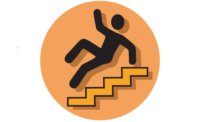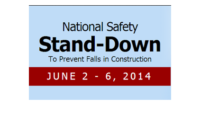As the second leading preventable workplace injury, falls plague the workforce. The impact of fall related injuries is felt heavily in service-providing industries as well as transportation, utilities and the health care sector. According to U.S. Bureau of Labor Statistics, in 2018 falls to the same level resulted in 147,390 incidents causing 10 median days away from work per incident.
One of the top attributing factors in falls to the same level is balance. The National Safety Council articulates this causation as “the motion of the person generated by gravity following the individual’s loss of equilibrium.” Key to this assessment is the word “equilibrium”. Put simply equilibrium is our sense of balance. However, equilibrium is a result of complex physiological systems working in seamless concert with one another. Key components of these systems are the eyes (vision), inner ears (vestibular) and musculoskeletal system. Understanding the role each of these components plays helps us better train employees for successful fall prevention.
Component one: vision
We rely heavily on information relayed from the eyes to the brain to know where our bodies are in space. Inadequate visual input makes it difficult for the brain to properly assess depth and is detrimental to overall coordination. Without this critical feedback to our brain it becomes much more likely for us to miss a step when ascending stairs, stumble when navigating uneven terrain or misjudge the clearance needed to step over a stationary object.
When available, company sponsored routine eye exams should be promoted to the employee population. This service is widely available for little to no charge and can be incorporated into your next employee health and safety expo. Free eye charts and can also be accessed online along with instructions for use. It should be explicitly stated that any in-house eye exams are not intended to diagnose or treat. Further empower employees to see the world clearly with readily available eye-glass cleaners that can be used on personal eye wear and safety glasses.
Component two: vestibular
A major player in the synchronized process of balance during activities of daily living are the inner ears. Components of the inner ear key for balance are known as the vestibular system. A labyrinth of chambers and their carefully calibrated fluid levels constantly send signals to the brain about where our bodies are in space. Fluids in the inner ear and their movement, or lack thereof are largely responsible for these signals. When all is well this system will go unnoticed. When triggered, a variety of balance related issues may emerge. To highlight the sensitivity of the vestibular system, imagine sitting in swivel chair and being spun around rapidly multiple times. Upon standing up from the chair, we can visually confirm and physically feel that we are stationary but will likely still feel a phantom spinning sensation due to fluid disturbances within the vestibular system.
Educating team members about the relevance inner ear health is key for fall prevention. Inner ear infections, vertigo as well as other illnesses like upper respiratory infections can be detrimental to balance. Side effects of prescription medication and dehydration are also known to influence the vestibular system and negatively impact equilibrium. Employees should be encouraged to communicate symptoms that pertain to equilibrium to a supervisor for further assessment. These include even brief sensations of spinning, lightheadedness, dizziness, etc.
Component three: musculoskeletal
Comprised of the body’s muscles, bones, joints and connective tissues - the musculoskeletal system is constantly challenged to keep pace with demands of daily life. Injuries to any component of the musculoskeletal system can directly or indirectly contribute to lapses in equilibrium leading to falls. Prior or nagging injuries including back pain or a self-proclaimed bad joint should be properly considered. Ailments like these may place the employee at an increased risk for a fall or other injury. When possible, proper rehabilitation is ideal. In the case that full injury rehabilitation is not an option, the individual’s ability to safely complete routinely required tasks should be considered. Note that the human body’s tendency to compensate for pain or restricted movement is usually to overcompensate with asymmetrical movements that protect the injury. Limping, a shuffling gate, even limited range of motion in a shoulder can create higher risk of injury.
Strength, stability, agility and flexibility are all attributes of the musculoskeletal system that can be evaluated and trained for improved outcomes. The development of relevant physical assessments that mirror routine physical demands allows hiring managers insights to an individual’s competency in their role. These initial assessments and ongoing reassessments serve to enforce cultural expectations for employee’s personal commitment to their well-being. Task specific training and treating employees as “industrial athletes” is an excellent way to reduce injuries and improve productivity.
2 minute fall prevention drill *
- Begin standing upright with weight evenly distributed to both feet. Shift weight to the right foot as much as possible. Left foot can maintain a point of contact with the ground or hover over the ground.
- Balancing on the right foot, close the eyes removing visual input. Feel the effect that removing visual input has on stability and balance. Aim to keep the eyes closed for 20 seconds.
- With eyes still closed, still balancing on the right foot, slowly turn the head side to side then up and down. Repeat this movement in varied sequences for 20 seconds, causing a disturbance to the vestibular fluid of the inner ear.
- Eyes remain closed, continue to balance on one foot. Hinge at the hip with back flat to lean slightly forward as if picking up an object from a low platform. Moving safely, vary the direction of your reach from side to side and overhead for 20 seconds.
- Open eyes, both feet return to the ground, recover. Repeat this process on the left leg.
Expand daily warm-ups with this drill, or introduce it in your next safety meeting. The step by step removal of key equilibrium components will help demonstrate the importance and sensitivity of these systems to employees. The practice of maintaining balance when tested will translate to improved physiological outcomes that reduce the risk of falls within your workforce.
* This exercise should be attempted by individuals who do not have known health risks that increase susceptibility to fall, injury or illness. The drill is intended to be completed in a safe location where the individual can easily brace themselves on a nearby stationary object if needed. The drill should be stopped at anytime in the case that the individual performing the drill or a supervisor feels these movements are placing the individual at risk of injury or illness.



